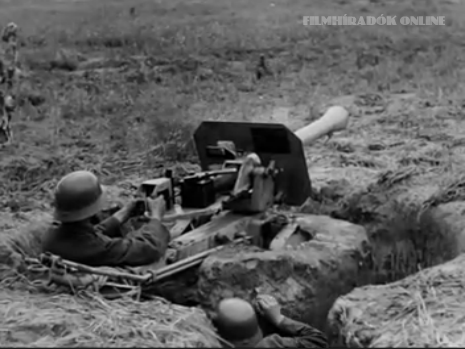Anti-tank/infantry Rockets
- Jacky 95
- Apr 12, 2018
- 3 min read
In 1942, to counteract the appearance of Soviet heavy tanks and the overall Soviet armor dominance, the Hungarian Institute of Military Science (HTI) started their own anti-tank rocket development
Two years later, this development cycle resulted in two unguided anti-tank rocket systems, the 44.M 60mm Páncélrém and the 44.M 100mm Buzogányvető.
The 44M. 60 mm hand-held rocket launcher a.k.a. “Páncélrém”, which was very similar to the well known German 88 mm Panzerschreck and to the american Bazooka. Intended against average light and medium tanks.
The 100 mm 44M. Buzogányvetőwhich was developed exactly against heavy tanks and fortified bunkers.
The Hungarian 15 cm 43.M multiple rocket launcher. (License built German 15 cm Nebelwerfer 41) Used on the Hungarian ME 210 CA-1 heavy fighter and on the Zrinyi I
The 44.M Lidérc ground-to-ground rocket
The 100 mm 44M. Buzogányvető used the Iron sight of the Schwarzlose machinegun
Two types of this 100 mm rocket were created: the anti-tank HEAT rocket of the Buzogányvető was called ’Buzogány’ (= mace), and the anti infantry HE rocket was called ’Zápor’ (= rainfall, shower).
The first prototype Buzogány HEAT rocket was finished and tested in the Spring of 1944. The largest diameter of the rocket was 215 mm, and with the cca. 4 kg explosive shaped charge in it, it was able to penetrate more than 300 mm of armour or concrete. This means that this rocket was able to destroy any kind of heavy tank of that time at 500-1200m distance.
A warhead flew with the speed of 200 km/h.
The weapon had such low ballistics that the aiming happened through the iron sights of a machine gun, and what is more important it did not had a smoke trail so the weapon could not be located after the first shot. The tri-pod version was the test weapon, the weapons given to the troops were all mounted on the wheels of looted Russian PM M1910 and SG-43 Goryunov machine guns.
Approximately 600-700 Buzogányvető systems were manufactured in the WM Factory before in 20 December 1944, when Soviet troops captured it. Nearly all manufactured rocket launchers were deployed and used in the siege of the Hungarian capital, Budapest.
This rocket system was either operated simply from the ground, or from Krupp Protze,or Rába Botond truck flatbeds and at least one was mounted on a Toldi II light tank.
During the Battles around Budapest and during the siege of Budapest, the 44.M Mace rocket system was widely used on the Krupp-Protze vehicles.
This truck and Mace rocket combination was very effective against Soviet tanks and had great demoralization effect on the Soviet troops. Due to the fast-moving truck platform they never know what hit them or from where.
Toldi II LT with 44M. Buzogányvető anti-tank rocket launcher
The 100 mm 44M. Buzogányvető
Iron Sight of the 44M Buzogányvető
The Hungarian 15 cm 43.M multiple rocket launcher.
These rockets were used on the Hungarian ME210 CA-1 in groups of 3 tube under each wing, and on the Zrínyi 1
The 44M. 60 mm hand-held rocket launcher
The 44.M Lidérc ground-to-ground rocket
After the American bombing raids on Germany the Hungarian government foresaw the fate of the country. To counter the huge American bomber formations multiple ideas were born. One of them was the Lidérc. This rocket was planned to be an air-to-air rocket - the second one in world wide after Germany -, but was special ofit's kind. Namely the Lidérc was equipped with a proximity fuse which was a first attempt world wide, all other missles of that time had time or impact action fuzes. It also had an impact augmenting chemical-fragment cover.
The proximity fuse was activated by the sound waves of the engines so it needed to be fired right into the middle of a bomber formation. The rocket itself was made out of two tubes to simply put it. The inner tube consisted the propellant material, while the space between the inner tube and the outer cover was filled with a mixture of thermite and barium oxide. This mixture caused an aquamarine smoke and multiple small fragments.
The rocket was 1430 mm long, 130 kg heavy and had a diameter of 295 mm. Shooting tests were carried out in summer 1944, the longest range it flew was 8000 meters. However the frontline got closer and closer and only 3 or 4 shotting tests were done.
The Lidérc was never used as an air-to-air rocket because Hungary did not had a proper aircraft which could carry it, however it was used as a ground-to-ground rocket.
Around 60 or 70 null-series rockets were made and they were all used in the Siege of Budapest, Operation Konrad and Operation Spring Awakening. They were fired from special reusable launcher tubes.
At the battles around Csepel island they were seen being fired from Botond flatbed trucks. And after the fired rockets exploded the affected area was burning with 1 meter tall blueish-green flames
The German 8.8 cm Rocket louncher

































Comments